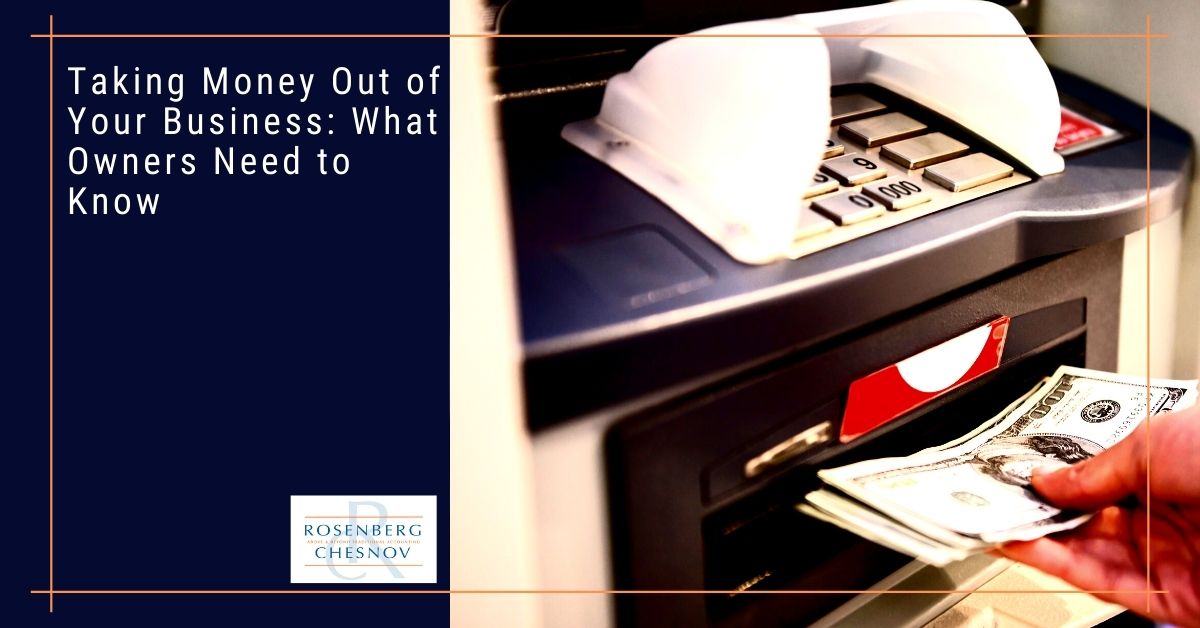

Understanding the FTC Safeguards Rule: A Business Owner’s Guide
Category: Accounting
Building and growing a successful business is hard work. It can take years before you begin to see a profit. As your success increases, however, you will want to withdraw money from the company.
That is, after all, the idea.
There are many common reasons business owners choose to do this. Beyond paying themselves, it can even promote future growth and stability for the business. But making a withdrawal the wrong way can lead to unwanted tax consequences, or worse: damage to the business entity itself.
Business owners who don’t have an informed plan for taking money out of their business are setting themselves up for failure. In this article, I’ll cover:
For a better sense of what it means to take money out of your business, and what you need to know before doing so, read on.


There are plenty of reasons to take money from your business and many ways to do it.
Some owners are hesitant to withdraw revenue, worrying that they are taking away profits. While it’s difficult to overstate the importance of thorough planning and correct structure, owners who never take any money out of the business may be harming it long-term.
Here are some common reasons you may want to withdraw income from your business.
Proper financial management is critical to ongoing stability. A vital component of a sound business strategy is creating a sufficient buffer of funds outside the business that will not be in jeopardy should your company encounter an emergency.
Leaving funds in your business can be risky, as they can be vulnerable to potential creditors, lawsuits, or unforeseen events. That’s why many business owners choose to withdraw a percentage of every dollar of income generated.
When your company is healthy and operating well, you can use this money for things like investments in the company or buying back stock from other shareholders.
The taxation of business withdrawals is complex and variable. Advantages, disadvantages, and processes will differ based on your entity structure (I’ll go into this in more depth later in this article). Broadly speaking, however, withdrawing money from your company can be an effective tax-saving strategy.
The most obvious benefit of minimizing taxable income is the opportunity to grow the business and reinvest earnings. Yet, there’s a second, less quantifiable benefit as well. Being engaged with and attentive to the financial management of your company will drive you to think more seriously about the direction of your company and how it will respond to cash flow issues.
Bear in mind that transactions such as these can negatively impact both you and your business, so it is crucial to take great care in their execution. As always, if in doubt, contact a tax professional.
The costs of owning a business can seem overwhelming at times—especially for sole proprietors. Running your own company can be expensive, and that’s not to mention your investment of time.
Now, after hard work and a lot of patience, you are finally ready to take some of the profits out of your business to cover your personal expenses – and for YOU.
How do you do that the right way? The structure of your business entity is a determining factor.
Owners of S and C corporations may pay themselves a salary or through earnings distributions.
Partnership owners may use distributions or guaranteed payments. Guaranteed payments are essentially salaries, with one significant difference: there is no withholding for payroll or income taxes.
Finally, sole proprietors pay themselves using an owner’s draw (taking company money for personal use).
For shareholders of S and C corporations, there are incentives to skew their wages one way or the other for tax savings.
If you elect to pay yourself a salary, though, the IRS requires you to make sure that the amount is “reasonable.” That is to say; you can neither inflate nor deflate your salary beyond an amount approximate to what someone in your industry would receive for similar services in an unrelated company.
Many entrepreneurs choose to pay themselves a fixed percentage of profit so that their salary can grow as the business does.
To withdraw funds from your company without incurring penalties or tax consequences, you’ll need to understand the type of business entity you own. Are you a sole proprietorship? A partnership? An LLC? An S or C corporation? The answer will impact the structure of the transaction.
Each type of business entity has a different tax classification and will have different requirements for taking money out. You need to ensure the withdrawal meets these requirements and is not a breach of any other regulations.
Below, I will discuss ways you can approach taking money out of different types of business entities.
In a sole proprietorship, there is no legal distinction between the business owner and the business entity. This can be a double-edged sword; for example, the sole proprietor keeps one hundred percent of the profits from their business but is also one hundred percent responsible for all losses and debts. Furthermore, business profits are subjected to taxation on the sole proprietor’s personal return.
When it comes to taking money out of the business, sole proprietors have the most uncomplicated process. They can make withdrawals at any time, simply by transferring from the business to their personal bank account or by writing a check from the business account. This is the aforementioned “owner’s draw,” and this transaction has no tax ramifications and is not a deductible business expense.
A partnership is precisely what it sounds like—a formal arrangement between two or more individuals, businesses, organizations, schools, or governments to manage and operate a business and share its profits. Like a sole proprietorship, partnerships pass all income on to the owners or investors. This is a “flow-through” or “pass-through” entity, a category that also includes S corporations.
Flow-through entities do not distinguish between the business owner and the business itself. So owners of partnerships report their income on their personal returns, even when there has not been a distribution.
Both S and C corporations differ critically from sole proprietorships and partnerships in that they are separate legal entities created by a state filing. The key distinction between these two kinds of corporations is the form of taxation.
“C corporation” is the IRS’s standard corporate designation. Shareholders, or owners, of C corporations, can take money out of the company in two ways: salary and wages or dividends. These corporations pay income taxes on all profit, including profit distributed to shareholders.
Additionally, those distributions are taxed again as individual income on the shareholders’ personal returns and are not deductible for the corporation. That means any C corporation profits distributed to shareholders are ultimately taxed twice.
There are also advantages to owning a C corporation. There are no limits on the number or type of shareholders, no restrictions on the class of stock, more options for raising capital, and a flat 21% maximum tax rate.
S corporations, as previously mentioned, are flow-through entities, similar to proprietorships and partnerships—the key difference, again, being that S corporations are separate legal entities. Shareholders of S corporations may also take money out through salaries or distributions. While these distributions are not deductible for S corporations, either, in this case, they are also non-taxable for the shareholder who receives them.
S corporations are subject to certain limitations. For example, they can not have more than one hundred shareholders, all of whom must be individuals and United States citizens or residents. There are also restrictions on the sale or transfer of shares and the class of stock. But flow-through taxation and a 20% qualified business income deduction give this type of entity advantages, as well.
Limited Liability Companies are more complex. Their taxation may take several different forms. They are partnerships by default, but LLCs may elect taxation as either a C or S corporation.
Depending on an LLC’s classification, different rules may apply. The owner of a single-member LLC may withdraw money from the company as needed. All owners of a multi-member LLC must agree on the distribution arrangement. Finally, if the LLC so elects, it can be subject to the S or C corporation rules.
As a final note: there is one very important rule that applies across the board.
Regardless of what type of business entity you own, you must never intermingle funds. This is one of the most dangerous financial mistakes you can make. Paying personal expenses from the business checking account, or paying business expenses from your personal account, can leave an opening for the IRS or courts to question the integrity of your business or transactions.
It is essential to your success that you maintain a complete financial separation between your business and personal finances. Failure to do so can result in severe tax and legal trouble.
If you are a client and would like to book a consultation, call us at +1 (212) 382-3939 or contact us here to set up a time.
If you aren’t a client, why not? We can take care of your accounting, bookkeeping, tax, and CFO needs so that you don’t have to worry about any of them. Interested? Contact us here to set up a no-obligation consultation.


Category: Accounting


Category: Management


Category: Management
Send us a message and we will contact you as soon as possible.
Send us a message and we will contact you as soon as possible.
Jeff Coyle, CPA, Partner of Rosenberg Chesnov, has been with the firm since 2015. He joined the firm after 20 years of business and accounting experience where he learned the value of accurate reporting, using financial information as a basis for good business decisions and the importance of accounting for management.
He is a diligent financial professional, able to manage the details and turn them into relevant business leading information. He has a strong financial background in construction, technology, consulting services and risk management. He also knows what it takes to create organizations having built teams, grown companies and designed processes for financial analysis and reporting.
His business experience includes:
Creating and preparing financial reporting, budgeting and forecasting.
Planning and preparation of GAAP and other basis financial statements.
Providing insight on financial results and providing advice based on those results.
Jeff also has a long history of helping individuals manage their taxes and plan their finances including:
Income tax planning and strategy.
Filing quarterly and annual taxes.
Audit support.
General financial and planning advice.
Prior to joining the firm in 2015, Jeff was in the private sector where he held senior financial and management positions including Controller and Chief Financial Officer. He has experience across industries, including construction, technology and professional services which gives him a deep understanding of business.
Jeff graduated from Montclair State University, he is a CPA and member of the American Institute of Certified Public Accountants, New York State Society of Certified Public Accountants and New Jersey State Society of Public Accountants.
Jody H. Chesnov, CPA, Managing Partner of Rosenberg Chesnov, has been with the firm since 2004. After a career of public accounting and general management, Jody knows the value of good financials. Clarity, decision making, and strategy all start with the facts – Jody has been revealing the facts and turning them into good business results for more than three decades.
He takes a pragmatic approach to accounting, finance and business. His work has supported many companies on their path to growth, including helping them find investors, manage scaling and overcome hurdles. His experience and passion for business reach beyond accounting and he helps businesses focus on what the numbers mean organizationally, operationally and financially.
He has a particular expertise in early-stage growth companies. His strengths lie in cutting through the noise to come up with useful, out of the box, solutions that support clients in building their businesses and realizing their larger visions.
Prior to joining the firm in 2004, Jody was in the private sector where he held senior financial and management positions including General Manager, Chief Financial Officer and Controller. He has experience across industries, which gives him a deep understanding of business.
Jody graduated with a BBA in Accounting from Baruch College, he is a CPA and member of the American Institute of Certified Public Accountants and New York State Society of Certified Public Accountants.
In addition to delivering above and beyond accounting results, Jody is a member of the NYSCPA’s Emerging Tech Entrepreneurial Committee (ETEC), Private Equity and Venture Capital Committee and Family Office Committee.
He is an angel investor through the Westchester Angels, and has served as an advisor for many startup companies and as a mentor through the Founders Institute.